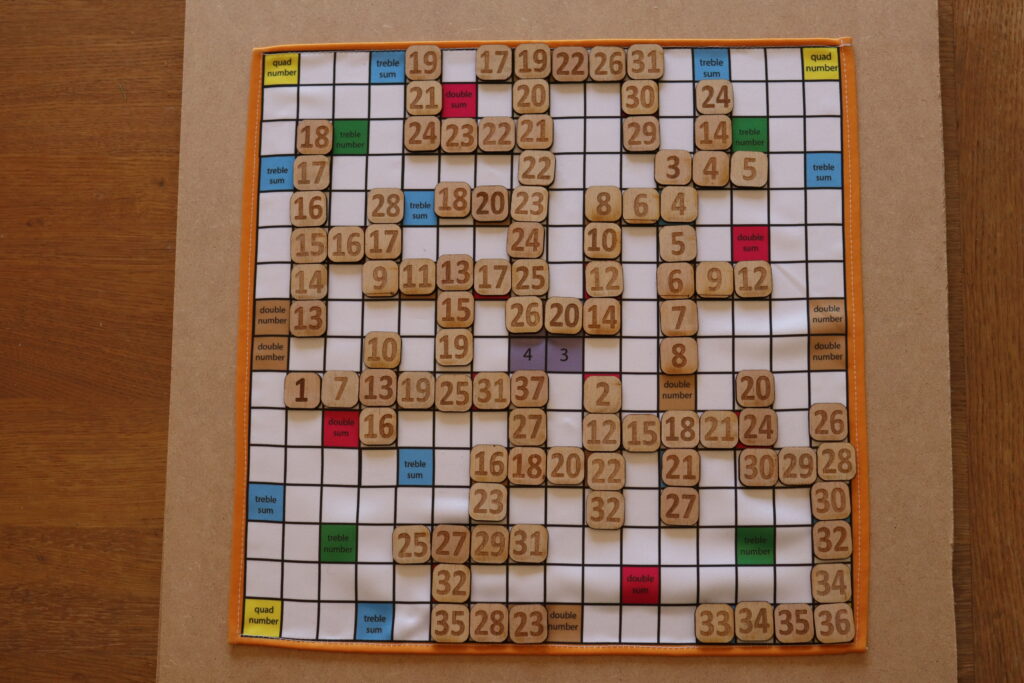
Game Description
The sequence of game playing of game#2 Wanchancy is listed here where items in each entry are sequence number, starting co-ordinate (x,y), actual sequence and score. The co-ordinate (1,1) is the bottom left corner of the play board. This is a specific game of two players where odd entries are player #1 and even entries are player #2. The game can have, however, up to four players. Where the sequence is not a simple arithmetic one then the formula to derive sequence elements is included. Thus the sequence 11, 13, 16, 20, 25 is created by: a(n+1)=a(n)+n where n=1, 2, 3, etc. with n(1)=11 as an example. This information can allow other players to add to the sequence in due course.
In the current game about a quarter of plays use such sequence formulae.
Numbers in round brackets indicate tiles that were already on the board. Numbers in square brackets indicate bonus scores where:-
dn = double number; tn = treble number; qn = quad number
ds = double sum, ts = treble sum
The player who goes first gets double sum.
In recording the game the primary sequence of digits played is displayed together with additional sequences created at the same time.
Scores for the games were PLAYER #1 2202 : PLAYER #2 2589 so player #2 was the winner. The game took around 2 hours to play for around 40 total ‘plays’ on the board. It is possible to play a shorter game of a set number of ‘plays’ – e.g. 20 plays would have reduced the game duration to around 1 hour.
Details of Play
#1; (8, 11) ; 24, 25 , 26 (x2 to start) = 150
#2; (5, 10) ; [11 dn], 13, 17, [25 ds] = 154
a(n) = a (n-1) + 2^(n -1)
#3 (6, 10) ; 13, 15, 19 = 47
a(n)=a(n-1)+2(n-1)
#4 ; (5, 7) ; [19 dn], (25), [31 ds] = 188
#5 (8,9) ; (26), 20, 14 = 60
#6 (4,8) ; 10, 13, 16 = 39
Include 13, (19, 25, 31) = 98
#7 ; (10, 11) ; 10, [12 ds], 14 = 72
#8 ; (2, 7) ; 1, 7, (13, 19, 25, 31) = 96
#9 ; (8, 12) ; 23, (24, 25, 26) = 98
#10; (8, 7) ; 37, 27, 18 = 82
a(n) = a(n-1) – (12-n)
Include (1, 7, 13, 19, 25, 31), 37 = 133
#11; (8,5) ; 18, 20, 22 = 60
#12 ; (10, 6) ; 12, (22), 32 =66
#13; (6, 12) ; 18, 20, 23 = 61
a(,n) = a(n-1) + n
#14; (10, 6) ; (12), 15, 18, 21 = 66
#15; (14, 7) ; 20, [24 ds], 30 = 148
a(n) = a(n-1) + 2n
Include (12, 15, 18, 21, [24ds] = 180
#16; (14, 5) ; (30), 29, 28 = 87
#17 ; (8,15) ; 20, 21, 22, (23, 24, 25. 26) = 161
#18 ; (16, 6) ; 26, (28) , 30, 32 = 116
#19 ; (7, 5) ; (16), 23, 29 = 68
a(n) = a(n-1) + (9-n)
#20; (5, 3) ; 25, 27, 29, 31 = 112
#21; (16, 6) ; (26, 28, 30, 32) = 116
#22; (16,6) ; (26, 28, 30, 32, 34, [36qs] =294
#23; (6,3)) ; (27), [32 ds] , 35 = 188
a,(n) = a(n-1) + (9-2n)
#24 ; (14, 1) ; 34, 35, 36 = 105
#25; (7, 16) ; 17, (19), 22, 26 = 84
#26 ; (6, 1) ; (35), 28, 23 = 86
a(n) = a(n-1) – (11-2n)
#27; (4,12) ; 28, 17, 9 = 54
a(n) = a(n-1) – (17-3n)
#28; (10, 12) ; [8 dn], 6, [4 ts] = 78
#29; (2, 11) ; 15, [16 ds], 17 = 96
#30; (10, 7) ; [2 ds], (12, 22, 32) = 136
#31; (12, 6) ; (18), [21 ts] , 27 = 198
a(n) = a(n-1) +3n -3
#32 ; (13, 1) ; [33 ts], 34, 35, 36) = 414
#33; (7, 16) ; (17, 19, 22, 26), 31 =115
#34; (2, 14) ; 18, 17, 16, (15) = 66
#35; (6 14) ; 23, 22, (21) = 66
#36; (12, 12) ; (4), 5, [6 dn] , 7, 8 = 36
#37 ; (12, 13) ; 3, (4, 5, 6, 7, 8) = 33
Include 3, 4, 5 = 12
#38; (5, 16) ; 19, 21, 24 = 64
Include 24, (23, 22, 21) = 90
#39 ; (13, 15) ; 24, 14, 4 = 42
#40; (12, 10) ; 6, 9, 12 = 27
#41; (2, 14) ; (18, 17, 16, 15), 14, 13 = 93
#42; remainder 11 + 33 = 44
End of script
Further Details of Game
Documentation for the game is available by searching ‘How to play Wanchancy’ on Amazon.
Copies of WANCHANCY game are available from Douglas Clarkson via eBay.